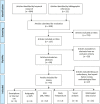Digital phenotype of mood disorders: A conceptual and critical review
- PMID: 35958638
- PMCID: PMC9360315
- DOI: 10.3389/fpsyt.2022.895860
Digital phenotype of mood disorders: A conceptual and critical review
Abstract
Background: Mood disorders are commonly diagnosed and staged using clinical features that rely merely on subjective data. The concept of digital phenotyping is based on the idea that collecting real-time markers of human behavior allows us to determine the digital signature of a pathology. This strategy assumes that behaviors are quantifiable from data extracted and analyzed through digital sensors, wearable devices, or smartphones. That concept could bring a shift in the diagnosis of mood disorders, introducing for the first time additional examinations on psychiatric routine care.
Objective: The main objective of this review was to propose a conceptual and critical review of the literature regarding the theoretical and technical principles of the digital phenotypes applied to mood disorders.
Methods: We conducted a review of the literature by updating a previous article and querying the PubMed database between February 2017 and November 2021 on titles with relevant keywords regarding digital phenotyping, mood disorders and artificial intelligence.
Results: Out of 884 articles included for evaluation, 45 articles were taken into account and classified by data source (multimodal, actigraphy, ECG, smartphone use, voice analysis, or body temperature). For depressive episodes, the main finding is a decrease in terms of functional and biological parameters [decrease in activities and walking, decrease in the number of calls and SMS messages, decrease in temperature and heart rate variability (HRV)], while the manic phase produces the reverse phenomenon (increase in activities, number of calls and HRV).
Conclusion: The various studies presented support the potential interest in digital phenotyping to computerize the clinical characteristics of mood disorders.
Keywords: artificial intelligence; bipolar disorder; depressive disorder; digital phenotyping; machine learning; mood disorders.
Copyright © 2022 Maatoug, Oudin, Adrien, Saudreau, Bonnot, Millet, Ferreri, Mouchabac and Bourla.
Conflict of interest statement
The authors declare that the research was conducted in the absence of any commercial or financial relationships that could be construed as a potential conflict of interest.
Figures
References
-
- Pasztor E. Dawkins, R. 1989. (original edition 1982; reprinted 1983, 1987, 1988, 1989): the extended phenotype. Oxford Paperbacks, Oxford University Press, Oxford, UK. 307 Pp. F6.95. J Evol Biol. (1991) 4:161–161. 10.1046/j.1420-9101.1991.4010161.x - DOI
Publication types
LinkOut - more resources
Full Text Sources



